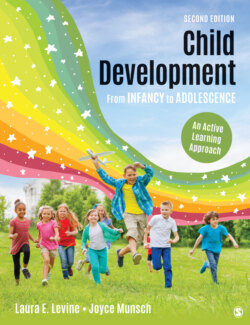Читать книгу Child Development From Infancy to Adolescence - Laura E. Levine - Страница 228
Teratogens
ОглавлениеEven with a healthy diet, good prenatal care, and plenty of exercise, a number of factors can have a negative impact on prenatal development. Agents that can cause malformations in an embryo or a fetus are broadly referred to as teratogens. They include diseases a mother has or contracts during her pregnancy, things she ingests, and toxins in the environment. Because there are so many potential teratogens, we can talk only briefly about some of the most common ones in this chapter.
Teratogens: Agents that can disrupt prenatal development and cause malformations or termination of the pregnancy.
Each teratogen has a specific effect on the developing embryo or fetus and can result in a structural abnormality, such as missing or malformed limbs, or a functional deficit, such as hearing loss or intellectual disability. Figure 4.5 shows the sensitive periods for the impact of various teratogens on development. The level of the impairment can range from mild to severe. The nature and magnitude of the effect depends on when in the prenatal period the fetus or embryo is exposed to the teratogen, the amount or dosage of the exposure, and the length of time the exposure continues. For example, an exposure that could end a pregnancy if it occurred early in the germinal stage might produce serious physical defects if it occurred during the embryonic stage but much less severe defects if it occurred late in the fetal stage.
Description
Figure 4.5 Sensitive periods in prenatal development.
Source: Moore, K. L., & Persaud, T. V. N. (2003). The developing human: Clinically oriented embryology (7th ed.). Philadelphia, PA: W. B. Saunders..
The effect when a woman contracts rubella or German measles at different points in her pregnancy is a good illustration of this point. The effect on an adult woman is rather mild, but the effects on her pregnancy can be devastating. Exposure in the first 11 weeks results in birth defects that include significant problems with vision, hearing, and heart function in 90% of cases, while exposure later in the pregnancy leaves 20% of infants with congenital defects (Reef & Redd, 2008). Although rubella is a relatively rare disease in the United States where children are routinely vaccinated against it, the World Health Organization (2014) estimates that worldwide 110,000 babies are born with the symptoms of a prenatal rubella infection each year. For this reason, it is important that children continue to be vaccinated for this disease so that women are not exposed to the virus during their pregnancy.
Teratogens. This adorable kitten can cause big problems to fetal development. When a pregnant woman cleans a litterbox, she risks contracting toxoplasmosis, an infection caused by a common parasite that can result in blindness or mental disability in her child (CDC, 2017o). The parasite is carried in the feces of cats that become infected by eating small rodents or birds and is spread through the dust from a litterbox, so pregnant women should not change kitty litter, if possible, or wear a mask and gloves if they must do so.
iStockphoto.com/absolutimages
